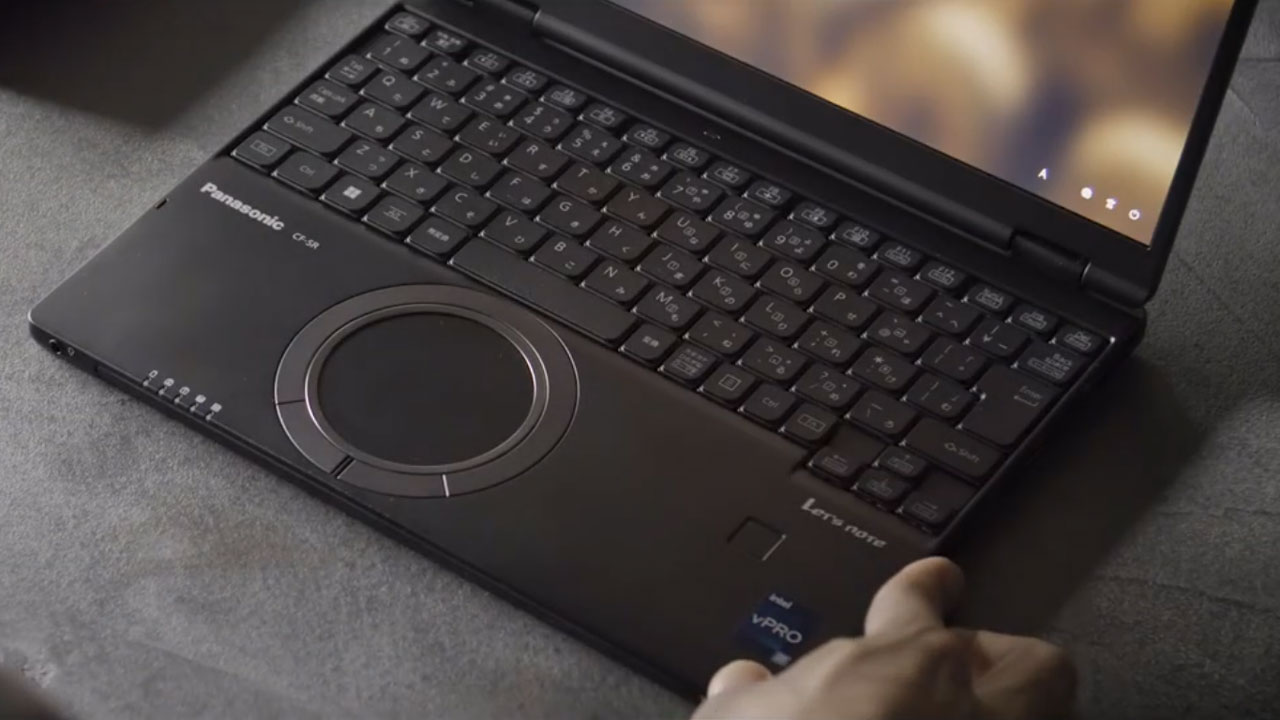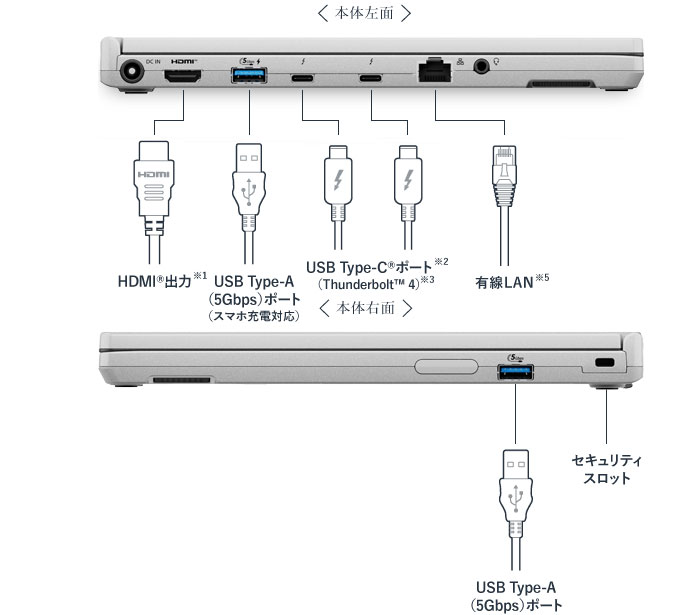Panasonic's new Let's Note laptops could be the final death knell for the humble VGA port
The 40-year-old standard has finally been discarded in the Japanese consumer space.

Earlier today, Panasonic announced refreshed models of its long-established Let’s Note laptop series. However, for the first time in its history, we have a Let’s Note portable that doesn’t have a VGA port. According to a report by Nikkei Japan (machine translation), this is probably the beginning of the end for laptops sporting VGA output, with “other companies to follow suit.”
A number of factors have precipitated Panasonic’s removal of the venerable VGA port. The Nikkei report highlights the strong competition from HDMI, which can simultaneously transmit audio. We also see that the new Panasonic Let's Note CF-SC6 models feature a pair of Thunderbolt 4 ports, which can also be used for video out. That’s three separate ports remaining on the Let’s Note to drive external displays.

Another disadvantage of VGA highlighted was that it is a rather bulky port for thin and light designs like the Let’s Note. At the refreshed laptop product launch today, size and weight were confirmed to be key considerations driving forward Panasonic’s consumer designs. The newest Let's Note laptop is just 919g in its 12-inch edition, and Panasonic Connect Executive Officer Kiyotaka Yamamoto said, "In addition to durability and long operating times, we will continue to focus on reducing the weight by even one gram."
In its favor, the Nikkei report cites the ruggedness of the VGA port. Moreover, a university professor it talked to indicated that turning to VGA can often be the answer when connection problems with HDMI occur. It seems like the educational market is one of the few remaining segments that appreciates the inclusion of a VGA port.
The 15-pin VGA port is a very old standard, originally arriving with the 1987 IBM PS/2 PC. This analog output doesn’t support as high resolutions and refresh rates as its modern rivals, of course, with the maximum specs 2048×1536px (QXGA) @85 Hz. Naturally, VGA is also losing support from visual output peripheral makers releasing new monitors, TVs, and projectors.
VGA ports long-gone from western brand laptops
Mainstream laptop brands available in the West mostly phased out VGA ports in the 2010s. Usually, HDMI took its place. More recently, popular American brands have sought to minimize laptop ports and standardize on Thunderbolt / USB-C for everything. This offers simplicity, standard docking equipment, and facilitates thinner/lighter portables.
Reading this news from the West, we are again struck by how ‘futuristic’ Japan seemingly clings to the oldest technologies. For example, we reported on Japanese bureaucracy still requiring floppy disks and/or optical media in the 2020s, despite efforts to phase them out.
Get Tom's Hardware's best news and in-depth reviews, straight to your inbox.
Nikkei reports that Panasonic was basically the last bastion of support for the VGA port in consumer laptops. Fujitsu phased out the port in 2019, and NEC too. Yet both these rivals appear to retain some designs with VGA ports for corporate markets.
Follow Tom's Hardware on Google News to get our up-to-date news, analysis, and reviews in your feeds. Make sure to click the Follow button.

Mark Tyson is a news editor at Tom's Hardware. He enjoys covering the full breadth of PC tech; from business and semiconductor design to products approaching the edge of reason.
-
PiersPlowman In Japan, the general philosophy accompanying technology is to use it until it blows up and the wheels fall off. And, given that Japanese tech is usually pretty good, it means tech remains serviceable well into obsolescence.Reply
In education, I have seen multimedia carts being wheeled around with tech dating back to the early 1990s, possibly earlier (cassette decks). I have even seen a few OHPs kicking around, but I confess to having a soft spot for them. Naturally, this equipment pre-dates HDMI, and by quite some margin, so you are left with the humble D-SUB to drive the projectors, which, incidentally, is the only piece of equipment that is periodically upgraded.
Trains are the same. Outside of the Shinkansen, rolling stock is 30+ years old, and the only upgrades I have seen are the display indicators that are now a white dot matrix display instead of an orange and green one. Absolutely no new upholstery on board, but when the seats are granite upholstered in coarse-woven Kevlar, I can see why the rail companies do not bother. -
wr3zzz 1. US government is still using floppy disks so let's not gloat too fast.Reply
2. Government contracts is likely the last market held by Japanese domestic PC/laptop makers and why so many legacy tech is still supported.
3. The only people who still think Japan as "futuristic" are people over 50... -
newtechldtech Reply
have you ever visited Japan ? They are still futuristic !wr3zzz said:3. The only people who still think Japan as "futuristic" are people over 50... -
Alvar "Miles" Udell VGA has uses since it's still ubiquitous in projectors and such, as was pointed out, but given how inexpensive, portable, and feature rich usb-c docks are, especially when they can also be plugged into a usb-c phone as well, there's little reason to keep including it on laptops.Reply -
bit_user I bought a server motherboard just 2 years ago, and the BMC on it still had support only for VGA! I had to buy a VGA -> HDMI converter, just so I could plug it into my KVM switch.Reply
The BMC chip is an ASpeed AST2500, which is fairly popular among OEMs who don't make their own BMC. I think the AST2600 finally added support for HDMI. -
bit_user Reply
VGA doesn't support HDCP. As such, copy-protected content often will not display over VGA.Alvar Miles Udell said:VGA has uses since it's still ubiquitous in projectors and such,
For a while, I had not a VGA monitor, but an old DVI monitor that lacked HDCP support, as a second screen. When I'd have a web browser open and a video ad would show some content that happened to be copy-protected, the screen would cut out. Very annoying.
Also, projectors wear out. The bulbs die (and you can only get replacements for so long), the pixels in the LCD or DLP screens get stuck. CRT projectors fade and get burn-in. This is a problem that eventually solves itself.Alvar Miles Udell said:VGA has uses since it's still ubiquitous in projectors and such, -
bit_user Reply
New floppy disks are no longer being made. Anyone using them won't have a choice but to transition, before long, as the supply of refurb disks is drying up.wr3zzz said:1. US government is still using floppy disks so let's not gloat too fast. -
SyCoREAPER Reply
Negative. They are however hesitant to adopting new technology and processes until it's absolutely necessary as a society. Tons of things that could be done electronically are still done in writing.PiersPlowman said:In Japan, the general philosophy accompanying technology is to use it until it blows up and the wheels fall off. And, given that Japanese tech is usually pretty good, it means tech remains serviceable well into obsolescence.
In education, I have seen multimedia carts being wheeled around with tech dating back to the early 1990s, possibly earlier (cassette decks). I have even seen a few OHPs kicking around, but I confess to having a soft spot for them. Naturally, this equipment pre-dates HDMI, and by quite some margin, so you are left with the humble D-SUB to drive the projectors, which, incidentally, is the only piece of equipment that is periodically upgraded.
Trains are the same. Outside of the Shinkansen, rolling stock is 30+ years old, and the only upgrades I have seen are the display indicators that are now a white dot matrix display instead of an orange and green one. Absolutely no new upholstery on board, but when the seats are granite upholstered in coarse-woven Kevlar, I can see why the rail companies do not bother.
As for the wheels fall off, the irony of you using that analogy is coincidentally funny (not in a making fun of you way). In Japan they actually get taxed out of this world for older vehicles and opt to buy new vehicles instead as it costs them far less annually in taxes. That's why there JDM scene gets all these low miles engines from Japan. Granted I've been out of the JDM scene for years so maybe laws have changed.
Anyway back in topic, VGA has its uses in IT for legacy purposes but for the average consumer, it's time to move on. There is no practical use for it anymore and don't even recall the last time I encountered a product with a VGA port.
It does make me think back to years back though working IT when we had a shipping sized recycling crate worth of cables, all that copper...
@bit_user I know you only said it for informational purposes but I sure wouldn't trust refurb floppies for anything critical. -
bit_user Reply
I was rocking a pair of 24" CRT monitors, until about 6-7 years ago. When I bought my GTX 980 Ti, I chose it specifically because its DVI connectors still had analog pins, meaning a simple cable or passive adapter could be used to hook it up to VGA monitors.SyCoREAPER said:Anyway back in topic, VGA has its uses in IT for legacy purposes but for the average consumer, it's time to move on. There is no practical use for it anymore and don't even recall the last time I encountered a product with a VGA port.
By contrast, the AMD RX Fury cards only supported digital out.
At my job, we still have lots of VGA and DVI cables wasting space in various bins and boxes.SyCoREAPER said:It does make me think back to years back though working IT when we had a shipping sized recycling crate worth of cables, all that copper...
There's no other option. If you're still using floppies, that's the only thing on the market for a few years, already. Inventories of unused disks are gone.SyCoREAPER said:@bit_user I know you only said it for informational purposes but I sure wouldn't trust refurb floppies for anything critical. -
bit_user BTW, here's a fun fact I learned only recently: most DisplayPort connectors are also capable of outputting HDMI signals. This standard is known as DisplayPort++ and usually (but not always) indicated via the logo:Reply
DisplayPort plus plusVideo Electronics Standards Association (displayport.org), Public domain, via Wikimedia Commons
This enables the use of cheap, passive cables or adapters. The alternative were expensive, hot, and potentially problematic active converters. Today, most DisplayPort -> HDMI cables and adapters you can buy are the passive kind.
Even if a DisplayPort doesn't have that logo, it's still probably worth trying to get a HDMI signal out of it, so long as the device is new enough (DisplayPort 1.2 or later, I think).